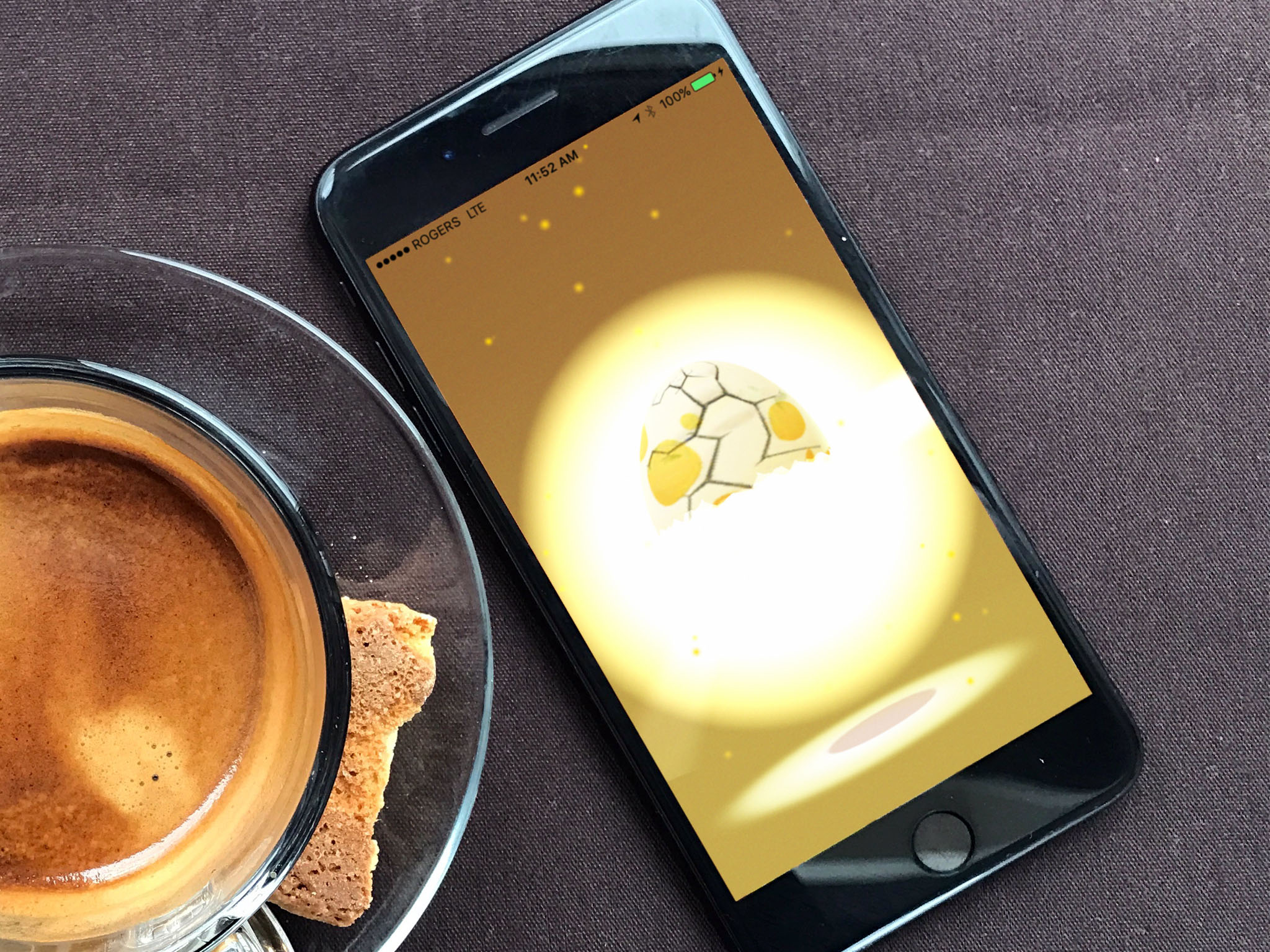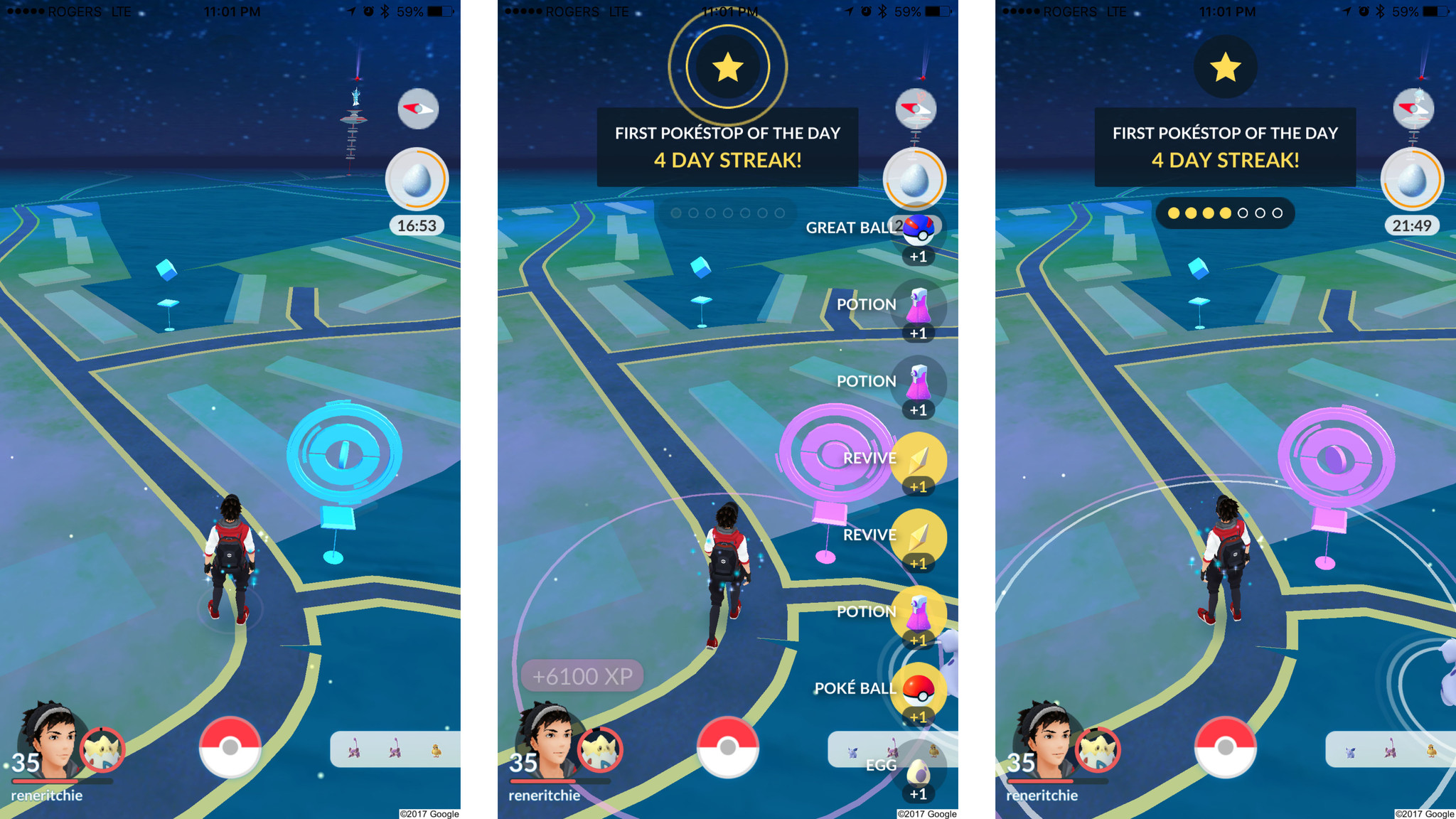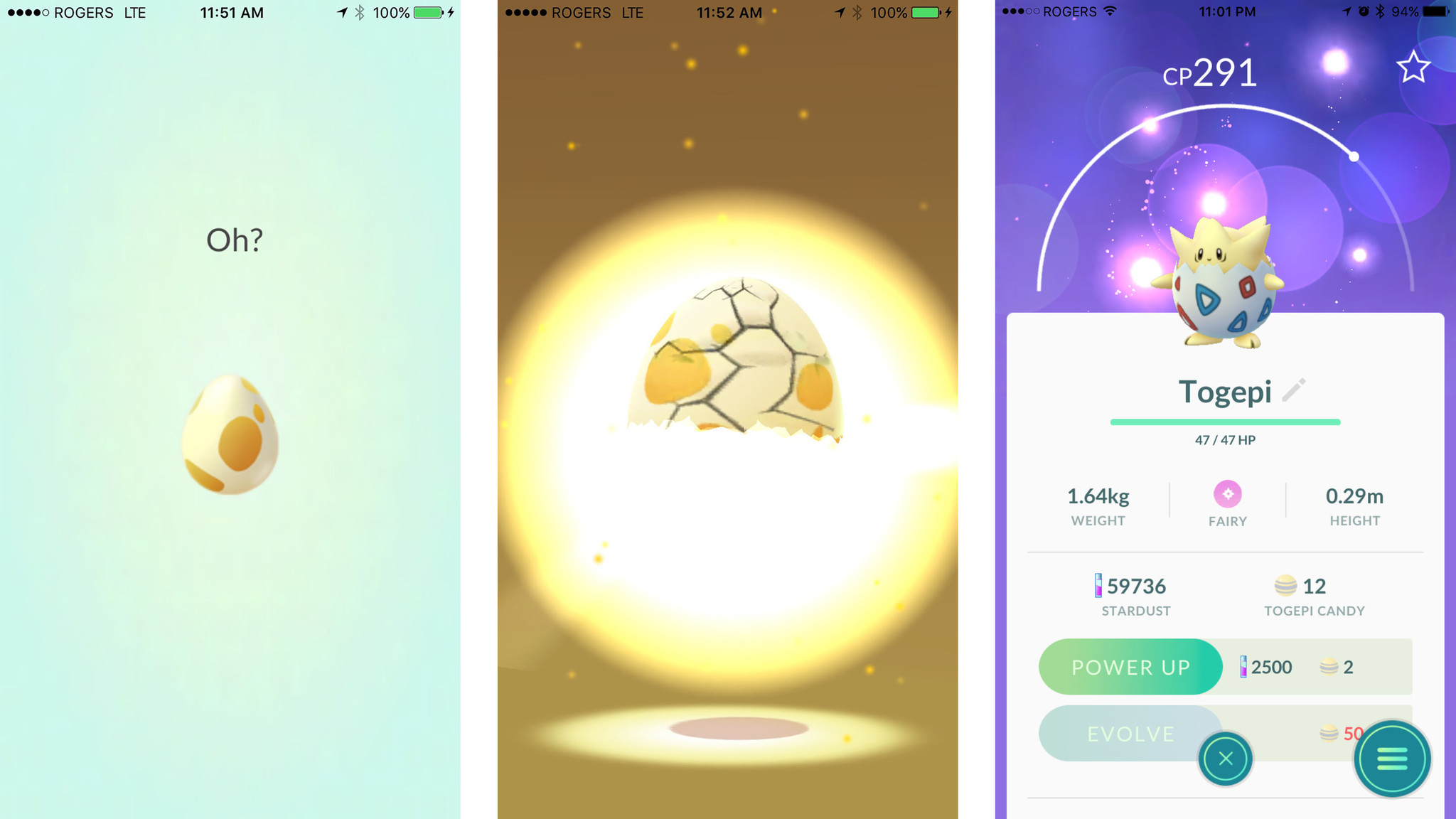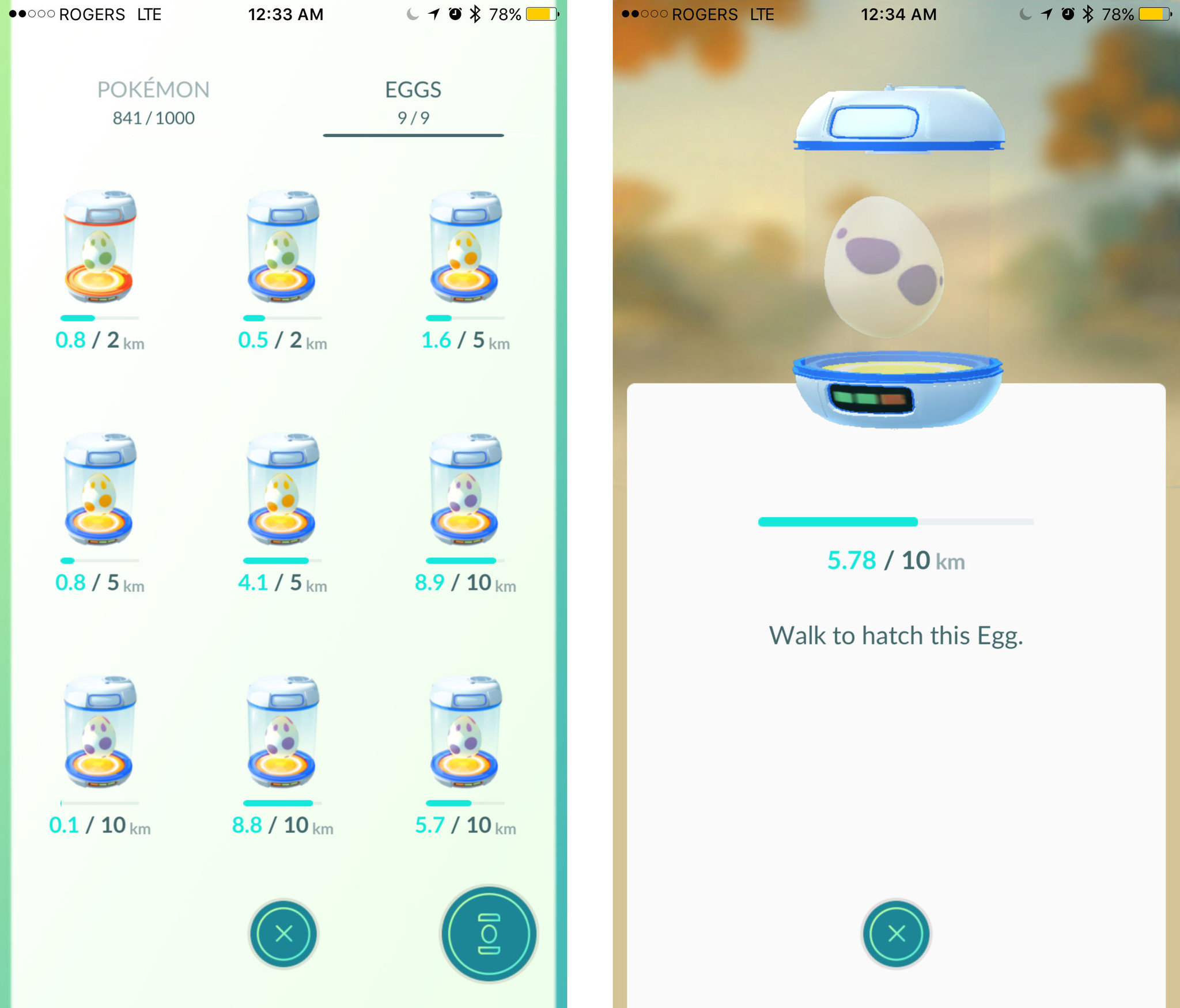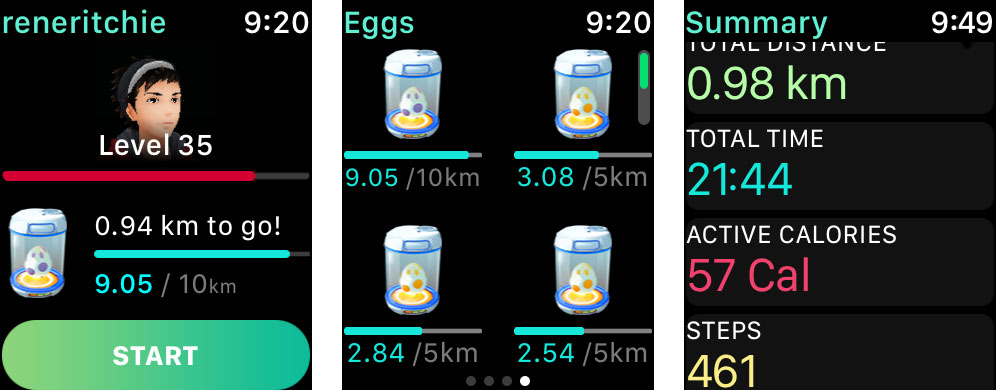Pokémon Go Eggs and how to hatch them faster
- jun
- 02
- Posted by Michael
- Posted in Okategoriserade
Which Pokémon can you hatch from 10 KM, 5 KM, and 2 KM Eggs? And what are the odds of hatching them? Here's the answer!
Pokémon Go isn't just about catching — hatching is a big part of the game as well. You get Pokémon Go eggs from spinning Poké Stops, incubate them, walk them for 2 KM, 5 KM, or 10 KM, and then hatch Pokémon from the common to the hyper-rare. Which Pokémon are in which Pokémon Eggs? And what's the best — read: fastest! — way to hatch them? Here's the updated list along with some tips and tricks — and maybe a cheat or two!
September 20, 2017: Super Incubators and special 2km eggs!
As a part of the Autumnal Equinox event starting on September 22, you'll be able to find Larvitar, Chansey, Mareep, and others in special 2km eggs. Perhaps more exciting is the addition of a new kind of incubator launching with the event. From Niantic:
You'll also be able to get special boxes from the in-game shop that feature items like Lucky Eggs, Lure Modules, and all-new Super Incubators which hatch Eggs 1.5 times quicker!
No doubt these Super Incubators are going to cost a little extra, but if you're trying to burn through what seems like an endless supply of 5km eggs so you can refill your inventory these might be the best way to go!
September 3, 2017: Latest changes to Pokémon Go Eggs examined and explained!
Following the Pokémon Go Anniversary Event in July, Pokémon Go once again made changes to the Pokémon Egg pools and rarity tiers. Here's what's been discovered.
From The Silph Road
We are now confident that changes occurred at the beginning of the Anniversary event on July 7th, with a minor change occurring at the event's end on July 23rd:
- 9 species have recently stopped appearing in eggs
- 13 species have been added (or restored) to eggs
- the rarity and egg distances of several species have been changed
. Additionally, the final and rarest tier has now been confirmed, per our suspicions months ago. Consequently, we have changed our nomenclature and have replaced ULTRA-RARE with SUPER-RARE; thus we call the newly confirmed rarity tier HYPER-RARE.
I've updated the lists below to reflect these changes.
August 21, 2017: New Super Incubator hinted at for Pokémon Go
There could be a new, faster Incubator coming to Pokémon Go in the near future. It would hatch eggs faster, at least for the single (or similarly limited) amount of uses it gets.
From The Silph Road:
The leaks surrounding the new incubator have continued, confirming its name in the APK code: the SUPER INCUBATOR!
It is currently believed that this incubator will hatch eggs faster than a standard incubator.
Interestingly, the incubator itself received a makeover this update, and the SUPER INCUBATOR has a unique (purple!) look as well. It is currently unknown whether this item will be purchaseable or given as an award.
What kind of Pokémon Eggs are there in Pokémon Go?
Aside from the very different Lucky Eggs, available in the Shop, there are three kinds of Pokémon Eggs in Pokémon Go:
- 2 KM Eggs with green spots.
- 5 KM Eggs with yellow spots.
- 10 KM Eggs with purple spots.
Each type of Pokémon Egg can hatch a different kind of Pokémon.
What are the rarity tiers for Pokémon Eggs in Pokémon Go?
After documenting 5,945 Pokémon Egg hatches since Halloween, The Silph Road shares:
Egg species is determined according to hidden rarity 'tiers' that are not the same as the egg distance tiers (i.e. 2 km, 5 km, 10 km).
In simple English, this means that not all 10 km egg species are rarer than 2 km egg species or 5 km egg species. A simple example of this is that Dratini is presently a very common hatch, despite being in 10 km eggs. It is currently easier to acquire a 10 km egg with a Dratini inside than a 2 km egg with a Machop inside.
The tiers seem to suggest that there's a 1:2:4:8 ratio for the tiers. That means you are 2x as likely to get a common egg as an uncommon one, 2x as likely to get an uncommon egg as a rare egg, and 2x as likely to get a rare egg as an ultra-rare egg.
What kind of Pokémon hatch from each type of Egg?
As of July, 2017, following the anniversary event, Pokémon Go has once again changed the type of Pokémon that hatch from Pokémon Eggs. The biggest changes include removing the Gen 1 starters, adding the Gen 2 starters, and moving many of the previously less-than-deseriable 10 KM hatches down to 5 KM.
2 KM Eggs
Common:
- Pichu (420)
- Nidoran (m) (422)
- Geodude (682)
- Krabby (792)
- Pichu (215)
Uncommon:
- Oddish (611)
- Diglett (265)
- Abra (656)
- Machop (685)
- Slowpoke (688)
- Ghastly (572)
- Exeggute (629)
- Spinarak (391)
- Cleffa (354)
- Igglybuff (293)
- Togepi (308)
- Aipom (678)
- Slugma (429)
Rare:
- Remoraid (428)
Super rare:
- Misdreavus (1,018)
5 KM Eggs
Common:
- Poliwag (397)
- Ponyta (858)
- Phanby (671)
Uncommon:
- Growlithe (634)
- Shellder (547)
- Drowzee (567)
- Voltorb (489)
- Cubone (539)
- Rhyhorn (959)
- Evee (553)
- Chinchou (610)
- Natu (528)
- Marill (240)
- Hoppip (290)
- Wooper (340)
- Swinub (379)
- Mantine (1,161)
- Stantler (1,136)
- Tyrogue (231)
- Smoochum (703)
- Elekid (613)
- Magby)
Rare:
- Seel (513)
- Onix (572)
- Tangela (1,262)
- Scyther (1,408)
- Pinsir (1,583)
- Chikorita (458)
- Cyndaquil (475)
- Totadile (578)
- Snubbul (642(
- Teddiursa (676)
- Houndour (634)
Super rare:
- Griber (725)
- Lickitung (755)
- Koffing (623)
- Omanyte (768)
- Kabuto (670)
- Pineco (597)
- Gligar (1,004)
- Qwilfish (1,091)
- Sneasel (1,067)
Hyper Rare:
- Wobbufet (585)
- Girafarig (1,064)
- Dunsparce (923)
- Shuckle (1710
10 KM Eggs
Uncommon:
- Porygon (895)
- Dratini (491)
- Mareep (506)
- Larvitar (517)
Rare:
- Chasey (839)
- Sudowoodo (1,180)
- Skarmory (1,161)
Super rare:
- Lapras (1,487)
- Aerodactyl (1,490)
- Snorlax (1,917)
- Miltank (1,321)
Are there any Pokémon that are only available from Eggs?
The babies!
- Pichu (baby Pikachu)
- Togepi (baby Togetic)
- Cleffa (baby Clefairy)
- Igglybuff (baby Jigglypuff)
- Magby (baby Magmar)
- Smoochum (baby Jinx)
- Elekid (baby Electobuzz)
Are there any Pokémon you CAN'T hatch from Eggs?
You can't hatch any evolved form Pokémon from Pokémon Eggs, only baby or base-level forms. So, you can't hatch a Pikachu, Dragonite or Tyranitar, but you can hatch the Pichu, Dratini, or Larvitar that evolve into them. You also can't hatch any Legendary or Mythical Pokémon, including the Legendary Birds, Legendary Dogs, Tower Duo, Celebi, Mew, or Mewtwo.
Other than that, you can't hatch Ditto, only catch it in disguise in the wild. And, although you could when the game first launched, you can no longer hatch regionals from eggs:
- Farfetch'd
- Kangaskhan
- Mr. Mime
- Taurus
- Heracross
- Corsola
Others have either been removed from eggs:
- Bulbasaur
- Squirtle
- Chambader
- Caterpie
- Weedle
- Pidgey
- Rattata
- Spearow
- Zubat
- Meowth
- Mankey
- Bellsprout
- Doduo
- Horsea
- Magikarp
- Sentrat
- Hoothoot
- Ledyba
- Sunkern
- Murkrow
- Snubbull
- Teddiursa
- Tentacool
- Psyduck
- Sandshrew
- Paras
And the regionals:
- Farfetch'd
- Kangaskhan
- Mr. Mime
- Taurus
- Heracross
- Corsola
But, I've hatched the Gen 1 starters from eggs, what gives?
Pokémon Go seems to currently be going back and forth between having the Gen 1 and Gen 2 starters in eggs. Right now, it's the Gen 2 starters turn again.
How do you get a Pokémon Egg?
Pokémon Eggs are different than the Lucky Eggs you get when you reach a significant new level or buy at the Shop. You can't buy Pokémon Eggs at all — You have to collect them at PokéStops. Spin the stop and there's a roughly 20% chance you'll get a Pokémon Egg along with the more common balls, potions, and revives.
That doesn't mean you'll get one egg every five stops, though. Random is random, which means you could get five eggs in a row or none at all. If you keep visiting and spinning PokéStops, though, you'll eventually get Pokémon Eggs.
New to Pokemon Go? Check out our ultimate guide first!
Where do you see Pokémon Eggs when you get them?
Pokémon Eggs are kind of hidden away but once you know where they are you can check on which ones you have, and how many, at any time.
- Tap the PokéBall button to bring up the menu.
- Tap the Pokémon button.
- Swipe from right to left to see your Pokémon Eggs.
You can have up to 9 Pokémon Eggs at any one time.
How can you tell which exact Pokémon is in a Egg?
You can't. Not until you hatch it. It's generally believed that when you spin a PokéStop and Pokémon Go determines you're getting an Egg, it first determines the Pokémon you're getting and then hides inside the appropriate type of Egg. For example, if it determines you're getting an Egg, it'll could then determine you're getting a Dratini, and so wrap it up inside a 10 KM Egg — and you can't see it or tell what it is until it comes out.
That means it doesn't matter where you are or what you do after you get an Egg. What's inside is already decided. It's also why, when Pokémon Go makes a change to Eggs for an event or any other reason, it won't affect Eggs you already have, only ones you get from that point on.
What about CP, Level, and stats (IV)?
The Level of a Pokémon in an Egg is the same as the Level of your Trainer when you acquire the Egg, up to a limit of Level 20. So, if you spin the PokéStop and get the Egg when you're Level 15, the Pokémon that eventually hatches from it will also be Level 15. If you're Level 20, 25, or 35, though, the Pokémon will be Level 20. That's as high as Eggs go. CP will match the Level.
For Stats (IV), Pokémon you hatch will be in the higher range:
- Mystic: 80-100%: "Your [Pokémon] is a wonder! What a breathtaking Pokémon!" or 66-79% "Overall, your [Pokémon] has certainly caught my attention."
- Valor: 80-100%: "Overall, your [Pokémon] simply amazes me! It can accomplish anything!" or 66-79%: "Overall, your [Pokémon] is a strong Pokémon. You should be proud!"
- Instinct: 80-100%: "Overall, your [Pokémon looks like it can really battle with the best of them!" or 66-79%: "Overall, your [Pokémon] is really strong!"
You can also look at the maximum CP numbers in the list above. The closer your Pokémon is to the top, the closer it is to being "perfect" — highest stats in every category.
Okay, how do you hatch a Pokémon Egg?
You hatch your Pokémon Eggs by placing them in Incubators and then walking around until you reach the number of kilometers indicated by the Egg.
Everyone gets one free "Infinite" Incubator that lets you incubate a single Pokémon Go at a time. Pokémon Go will also give you free three-use Incubators when you reach level 6, 10, 15, 20, 25, and 30, and four free when you reach level 40. To use them:
- Go to your Pokémon Egg screen.
- Tap on the Pokémon Egg you want to Incubate.
- Tap on Start Incubation.
- Tap on the Incubator you want to use.
You can also buy additional three-use Incubators from the Shop. They cost 150 Poké Coins and break after you've used them three times, but let you incubate as many Eggs as you have, all at the same time.
- Tap the Incubator button at the bottom right.
- Tap on the Shopping Bag button at the bottom right.
- Tap on the Incubator button.
- Tap on the Exchange For (150 coins) button.
You can also buy them from the Store screen if you're not already on the Egg screen. And you can buy as many as you like simply by tapping the Exchange For button repeatedly. (As long as you have enough Poké Coins.)
- Tap the PokéBall button to bring up the menu.
- Tap the Shop button.
- Tap on the Incubator button.
- Tap on the Exchange For (150 coins) button.
Note: Pokémon Go's Holiday Event gave away one free 1-use Incubator a day for the first PokéStop you spun and had discount Incubators available for sale. No telling when or if that'll happen again, but it's something to look out for!
Once you have the Pokémon Egg in the Incubator, you need to walk to hatch it. How far you have to walk correlates to the distance of the Egg you have.
- 2 kilometers for 2 KM Eggs (green).
- 5 kilometers for 5 KM Eggs (yellow).
- 10 kilometers for 10 KM Eggs (purple).
Does it matter what type of Incubator you use for each type of egg?
Any type of Incubator can be used to hatch any type of Pokémon Egg. That said, if you want the most from your Incubators:
- Put 2 KM eggs in your unlimited use Incubator first.
- Put 10 km eggs in your three-use Incubators first.
Look at it this way: If you have a 3-use Incubator and you use it for 2 km eggs, it'll disappear after 6 km. If you use it for 10 km eggs, you'll get 30 km out of it, or 5x the distance for your money.
Can you see how far you've traveled with a Pokémon Go Egg?
Yup! As you walk, the Pokémon Egg screen will update to show you the distance you've walked each Egg up to one decimal place. For example, if you walk 1.3 KM, you'll see 1.3 / 2 KM, 1.3 / 5 KM, or 1.3 / 10 KM.
If you tap on a Pokémon Egg, you can see the distance up to two decimal places.
The distance is updated every 4.2 minutes so, don't worry if you walk for a bit and don't see any immediate changes.
How fast can you walk to hatch a Pokémon Egg?
It's currently believed the optimal speed for hatching a Pokémon Go is 10.5 KM/H (6.5 M/H). Go slower and it'll just take you longer to hatch. Go faster and Pokémon Go will discount the distance you're traveling or, if you go fast enough, ignore it altogether.
If you reach 35 KM/H (22 MP/H), you'll get the speed-lock pop up. At that point, little if any of your distance will be counted.
Do you have to walk or can you jog, run, cycle, skate, ski... or drive?
You can travel any way you like, you just can't exceed 10.5 KM/H if you want all your distance to count, or 35 KM/H if you want anything to count at all.
If you've got a great way to go 10.5 KM/H, like on a scooter, skates, or cross-country skis, go for it!
Do you have to travel in a straight line?
Pokémon Go measures distance in a straight line based on the change in GPS position. So, to get maximum distance, you should travel in a straight line too.
It's believed that Pokémon Go actually records distance more frequently, though. Somewhere between one to four times a minute. So, you could theoretically change direction after a minute or so and still get good results.
Do you have to have Pokémon Go open while you're traveling?
For your distance to record, you have to have at least one of the following things:
- Pokémon Go open on your phone.
- Pokémon Go Plus connected to your phone.
- Pokémon Go for Apple Watch with a Workout started.
Are any one of those methods better than any other?
Currently, Pokémon Go for Apple Watch, once a Workout is started, doesn't record based on GPS but based on your step count, which means you don't have to worry about walking in a straight line. You can record distance while walking around your house, even using a treadmill.
Do you get anything else from hatching an Egg?
Yes! You also get XP, Candies, and Stardust. XP is always the same but candies and Stardust falls along a range.
- 2KM egg: 200 XP, 5 to 15 candies, 500-1500 Stardust.
- 5KM egg: 500 XP, 10 to 21 candies, 1000-2100 Stardust.
- 10KM egg: 1000 XP, 16 to 32 candies, 1600-3200 Stardust.
Any cheats to hatch Pokémon eggs faster?
There are, though some can start or stop working depending on how Pokémon Go updates. They include ways to benefit from "GPS drift", ways to get more distance when you're driving, and more.
Your Pokémon Go Egg hatching tips?
Do you have any tips, tricks, or cheats for hatching Eggs in Pokémon Go? Drop them into the comments and we'll try them out.
Senaste inläggen
- Kuo: Apple Watch Ultra 3 får knappt några hårdvaruuppgraderingar
- Google betalade Apple 20 miljarder dollar för att vara standardsökmotor
- LG:s tv-apparater får stöd för Dolby Atmos med Apple Music
- Upcoming iOS 18 iPhone software update tipped to finally bring tasks to the Calendar app via new Reminders integration
- Fallout Shelter has been raking in $80,000 daily since the TV show’s debut as downloads skyrocketed 346%
Senaste kommentarer
Arkiv
- maj 2024
- april 2024
- mars 2024
- februari 2024
- januari 2024
- december 2023
- november 2023
- oktober 2023
- september 2023
- augusti 2023
- juli 2023
- juni 2023
- maj 2023
- april 2023
- mars 2023
- februari 2023
- januari 2023
- december 2022
- november 2022
- oktober 2022
- september 2022
- augusti 2022
- juli 2022
- juni 2022
- maj 2022
- april 2022
- mars 2022
- februari 2022
- april 2021
- mars 2021
- januari 2021
- december 2020
- november 2020
- oktober 2020
- september 2020
- augusti 2020
- juli 2020
- juni 2020
- maj 2020
- april 2020
- mars 2020
- februari 2020
- januari 2020
- december 2019
- november 2019
- oktober 2019
- september 2019
- augusti 2019
- juli 2019
- juni 2019
- maj 2019
- april 2019
- mars 2019
- februari 2019
- januari 2019
- december 2018
- november 2018
- oktober 2018
- september 2018
- augusti 2018
- juli 2018
- juni 2018
- maj 2018
- april 2018
- mars 2018
- februari 2018
- januari 2018
- december 2017
- november 2017
- oktober 2017
- september 2017
- augusti 2017
- juli 2017
- juni 2017
- maj 2017
- april 2017
- mars 2017
- februari 2017
- januari 2017
- december 2016
- november 2016
- oktober 2016
- september 2016
- augusti 2016
- juli 2016
- juni 2016
- maj 2016
- april 2016
- mars 2016
- februari 2016
- januari 2016
- december 2015
- november 2015
- oktober 2015
- september 2015
- augusti 2015
- juli 2015
- juni 2015
- maj 2015
- april 2015
- mars 2015
- februari 2015
- januari 2015
- december 2014
- november 2014
- oktober 2014
- september 2014
- augusti 2014
- juli 2014
- juni 2014
- maj 2014
- april 2014
- mars 2014
- februari 2014
- januari 2014
Kategorier
- –> Publicera på PFA löp
- (PRODUCT) RED
- 2015
- 25PP
- 2nd gen
- 32gb
- 3D Touch
- 3D-kamera
- 4k
- 64gb
- 9to5mac
- A10
- A9X
- Aaron Sorkin
- Accessories
- adapter
- AirPlay
- AirPods
- Aktiv
- Aktivitetsarmband
- Aktuellt
- Alfred
- AMOLED
- Android Wear
- Angela Ahrendts
- Ångerätt
- announcements
- Ansiktsigenkänning
- app
- App Store
- Appar
- Apple
- Apple Beta Software Program
- Apple Book
- Apple CarPlay
- Apple Event
- Apple iMac
- Apple Mac Mini
- Apple Macbook
- Apple MacBook Air
- Apple MacBook Pro
- Apple Macos
- Apple Maps
- Apple Music
- Apple Music Festival
- Apple Music Radio
- Apple Offer
- Apple Online Store
- Apple Park
- Apple Pay
- Apple Pencil
- Apple Podcast
- Apple Store
- Apple Store 3.3
- Apple TV
- apple tv 4
- Apple TV 4K
- Apple Watch
- Apple Watch 2
- Apple Watch 8
- Apple Watch 9
- Apple Watch Apps
- Apple Watch SE
- Apple Watch Series 2
- Apple Watch Sport
- Apple Watch Ultra
- AppleCare
- AppleTV
- Application
- Applications
- Apps
- AppStore
- Apptillägg
- Apptips
- AppTV
- April
- Arbetsminne
- armband
- Art Apps
- Återköp
- återvinning
- Åtgärdsalternativ
- atvflash
- Audio Apps
- Augmented REality
- Back-to-school
- Bakgrundsbilder
- BankId
- Barn
- Batteri
- batteriskal
- batteritid
- Beats
- Beats 1
- Beats Solo 2 Wireless
- Beats Solo2
- Bebis
- Beginner Tips
- Belkin
- Bendgate
- beta
- Beta 3
- betaversion
- betaversioner
- bilddagboken.se
- bilder
- bilhållare
- billboard
- Bioteknik
- Blendtec
- Bloomberg
- Bloons TD 5
- Bluelounge
- Bluetooth
- Böj
- Booking.com
- Borderlinx
- bose
- bugg
- Buggar
- Buggfixar
- Butik
- C More
- Calc 2M
- Camera
- Campus 2
- Canal Digital
- Carpool Karaoke
- Caseual
- Catalyst
- CES 2015
- Chassit
- Chip
- Chrome Remote Desktop
- Chromecast
- citrix
- clic 360
- CNBC
- Connect
- Cydia
- Dagens app
- Dagens tips
- Damm
- Danny Boyle
- Data
- datamängd
- Datorer
- Datortillbehör
- Datum
- Defense
- Dekaler
- Designed by Apple in California
- Developer
- Development
- Digital Inn
- Digital Touch
- Digitalbox
- DigiTimes
- Direkt
- Discover
- display
- DisplayMate
- Dive
- Docka
- Dräger 3000
- Dropbox
- Droples
- DxOMark
- E-post
- earpod
- EarPods
- Earth Day
- Eddie Cue
- eddy cue
- Educational Apps
- Ekonomi
- Ekonomi/Bransch
- El Capitan
- Elements
- ElevationLab
- Elgato Eve
- Elgato Eve Energy
- EM 2016
- Emoji
- emojis
- emoticons
- Enligt
- EU
- event
- Eventrykten
- EverythingApplePro
- Faceshift
- facetime
- Fäste
- Featured
- Features
- Feng
- Film / Tv-serier
- Filmer
- Filstorlek
- Finance Apps
- Finder For AirPods
- Finland
- FireCore
- Fitbit
- Fitness Accessories
- Fjärrstyr
- Flurry
- Födelsedag
- fodral
- Förboka
- Force Touch
- förhandsboka
- Första intryck
- Forumtipset
- foto
- FoU (Forskning och Utveckling)
- Fource Touch
- Foxconn
- FPS Games
- Framtid
- Fre Power
- Frontpage
- Fullt
- Fuse Chicken
- Fyra
- Gadgets
- Gagatsvart
- Gamereactor
- Games
- Gaming
- Gaming Chairs
- Gästkrönika
- General
- Gigaset
- Gitarr
- Glas
- GM
- Google Maps
- Google Now
- gratis
- grattis
- Guide
- Guider
- Guider & listor
- Guld
- hack
- Halebop
- hållare
- Hälsa
- Hårdvara
- HBO
- HBO Nordic
- Health
- Health and Fitness
- Health and Fitness Apps
- Hej Siri
- Helvetica Neue
- Hemelektronik
- Hemknapp
- Hemlarm
- Hermes
- Hitta min iphone
- Hjärta
- högtalare
- HomeKit
- HomePod
- hörlurar
- htc
- Hue
- Humor
- i
- I Am A Witness
- IBM
- iBolt
- iBomber
- iBook
- icar
- iCloud
- iCloud Drive
- iCloud Voicemail
- iCloud.com
- iDevices
- IDG Play
- idownloadblog
- iFixit
- ikea
- iKörkort
- iLife
- Illusion Labs
- iMac
- IMAP
- iMessage
- iMessages
- iMore Show
- Incipio
- InFuse
- Inspelning
- Instagram-flöde
- Instrument
- Intel
- Internet/Webbtjänster
- iOS
- iOS 10
- iOS 12
- iOS 17
- iOS 18
- iOS 5
- iOS 7
- iOS 8
- iOS 8 beta
- iOS 8.1.3
- iOS 8.2
- iOS 8.3
- iOS 8.4
- iOS 8.4.1
- iOS 9
- iOS 9 beta 4
- iOS 9.1
- iOS 9.1 beta 2
- iOS 9.2
- iOS 9.2.1
- iOS 9.3
- IOS Games
- ios uppdatering
- ios9
- iPad
- iPad Accessories
- iPad Air
- iPad Air 2
- iPad Air 3
- iPad Apps
- iPad Mini
- iPad mini 4
- iPad Mini 6
- iPad mini retina
- iPad Pro
- iPados
- iphone
- iPhone 12
- iPhone 14
- iPhone 14 Pro
- iPhone 15
- iPhone 16
- iPhone 17
- iPhone 5
- iPhone 5S
- iPhone 5se
- iPhone 6
- iphone 6 plus
- iPhone 6c
- iPhone 6s
- iPhone 6S plus
- iPhone 7
- iPhone 7 display
- iPhone 7 Plus
- iPhone 7s
- iPhone Accessories
- iPhone Apps
- iPhone SE
- iphone x
- iPhone XS
- iPhone XS Max
- iPhone7
- iPhoneGuiden
- iPhoneguiden.se
- iPhones
- iPod
- iPod Nano
- iPod shuffle
- ipod touch
- iSight
- iTunes
- iWatch
- iWork
- iWork för iCloud beta
- Jailbreak
- James Corden
- Jämförande test
- Jämförelse
- Jet Black
- Jet White
- Jönssonligan
- Jony Ive
- Juice Pack
- Juridik
- Just mobile
- kalender
- kalkylator
- Kamera
- Kameratest
- Karriär/Utbildning
- Kartor
- Kevin Hart
- keynote
- Keynote 2016
- KGI
- KGI Security
- Kina
- Klassiskt läderspänne
- Kod
- Kollage
- koncept
- konceptbilder
- köpguide
- krasch
- Krascha iPhone
- Krönika
- Kvartalsrapport
- Laddhållare
- laddningsdocka
- Laddunderlägg
- läderloop
- lagar
- Lagring
- Lajka
- Länder
- lansering
- laserfokus
- Layout
- leather loop
- LG
- Liam
- Lifeproof
- Lightnigport
- lightning
- Linux
- LinX
- live
- Live GIF
- Live Photos
- Live-event
- Livsstil
- Ljud & Bild
- Logitech
- LOL
- Lösenkod
- Lösenkodlås
- Lovande spel
- LTE
- Luxe Edition
- M3
- M3TV
- Mac
- Mac App Store
- Mac Apps
- Mac Mini
- Mac OS
- Mac OS X
- Mac OS X (generellt)
- Mac OS X Snow Leopard
- Mac Pro
- Macbook
- Macbook Air
- Macbook Pro
- Macforum
- Macintosh
- macOS
- Macs
- MacWorld
- Made for Apple Watch
- magi
- Magic
- MagSafe
- Martin Hajek
- matematik
- Meddelanden
- Media Markt
- Medieproduktion
- Mediocre
- Messaging Apps
- Messenger
- MetaWatch
- Mfi
- Michael Fassbender
- microsoft
- Mikrofon
- Minecraft
- Ming-Chi Kuo
- miniräknare
- minne
- Mixer
- Mixning
- Mjukvara
- mobbning
- Mobile Content
- Mobilt
- Mobilt/Handdator/Laptop
- Mobiltelefon
- Mockup
- Mophie
- mors dag
- moto 360
- Motor
- MTV VMA
- multitasking
- Music
- Music Apps
- Music, Movies and TV
- Musik
- Musikmemon
- MW Expo 2008
- native union
- Nätverk
- Navigation Apps
- nedgradera
- Netatmo Welcome
- Netflix
- Netgear Arlo
- News
- Niantic
- Nike
- Nikkei
- Nintendo
- Nöje
- Norge
- Notis
- Notiscenter
- nya färger
- Nyfödd
- Nyheter
- Officeprogram
- Okategoriserade
- OLED
- omdöme
- Omsättning
- OS X
- OS X El Capitan
- OS X Mavericks
- OS X Yosemite
- Outlook
- Övrig mjukvara
- Övrigt
- PanGu
- papper
- patent
- PC
- pebble
- Pebble Smartwatch
- Pebble Steel
- Pebble Time
- Pebble Time Steel
- Persondatorer
- Petter Hegevall
- PewDiePie
- Philips
- Philips Hue
- Phones
- Photoshop
- Planet of the apps
- Plex
- Pluggar
- Plus
- Plusbox
- Podcast
- Podcast Apps
- Policy
- Porträttläge
- PP
- Pris
- priser
- problem
- Problems
- Productivity Apps
- Program
- Prylar & tillbehör
- Publik
- publik beta
- QuickTime
- räkenskapsår
- räkna
- ram
- RAM-minne
- Rapport/Undersökning/Trend
- Rea
- Reading Apps
- recension
- Red
- reklaamfilm
- reklam
- reklamfilm
- reklamfilmer
- rekord
- Rendering
- reparation
- Reportage
- Reptest
- ResearchKit
- Retro
- Review
- Ring
- Ringa
- Rocket Cars
- Rosa
- Rumors
- Rumours
- RunKeeper
- rykte
- Rykten
- Safir
- Säkerhet
- Säkerhetsbrist
- Samhälle/Politik
- samsung
- Samtal
- San Francisco
- SAP
- security
- Series 2
- Servrar
- Shigeru Miyamoto
- Sia
- Siri
- SJ Min resa
- skal
- Skal iPhone 6
- skal iPhone 6s
- skärm
- SKärmdump
- Skärmglas
- Skribent
- skribenter medarbetare
- Skriva ut
- skruvmejsel
- skydd
- Skyddsfilm
- Skype
- slice intelligence
- Smart
- smart hem
- Smart Home
- Smart Keyboard
- Smart klocka
- Smart Lights
- smartphone
- Smartwatch
- Snabbt
- Snapchat
- Social Apps
- Software
- Solo2
- sommar
- Sonos
- Sony
- soundtouch
- Space Marshals
- spår
- Speakers
- Special Event
- Spel
- Spelkonsol
- Spellistor
- Split Screen
- Split View
- Sport
- Sportband
- Sports Apps
- spotify
- Spring forward
- Statistik
- Steve Jobs
- Stickers
- Stockholm
- Stor iPhone
- Storlek
- Story Mode
- Strategy Games
- streama
- Streaming
- stresstest
- Ström
- Studentrabatt
- stylus
- Super Mario Run
- support
- Surf
- Surfplatta
- svenska
- sverige
- Sverigelansering
- Switch
- Systemstatus
- Systemutveckling
- tåg
- Taig
- Tangentbord
- Taptic Engine
- Tårta
- tät
- Tävling
- Taylor Swift
- Teknik
- tele 2
- Telefoner
- Telekom
- Telia
- Test
- Tid
- TikTok
- Tile
- tillbehör
- Tim Cook
- TIME
- TimeStand
- Tiny Umbrella
- Tips
- Toppnyhet IDG.se
- Touch ID
- TouchID
- tower defence
- trådlös laddning
- Trådlösa hörlurar
- trådlöst
- trailer
- Travel Apps
- Tre
- TrendForce
- TripAdvisor
- Trolleri
- trump
- TSMC
- Tum
- tv
- tvätta
- tvOS
- tvOS 9.2
- tvOS beta 2
- Tweak
- Typsnitt
- Ubytesprogram
- UE MegaBoom
- Unboxing
- Underhållning/Spel
- unidays
- United Daily News
- Unix
- Updates
- Uppdatera
- uppdatering
- Upplösning
- upptäckt
- USA
- Ut på Twitter
- utbyte
- utbytesprogram
- Utilities Apps
- Utlottning
- utrymme
- utvecklare
- varumärke
- Vatten
- Vattentålig
- vattentät
- vävt nylon
- Verktyg
- Viaplay
- Vibrator
- video
- Videoartiklar och webb-tv (M3/TW/CS)
- Villkor
- viloknapp
- Virtual Reality
- Virus
- visa
- Vision Pro
- VLC
- Volvo on call
- W1
- Waitrose
- Watch OS
- WatchOS
- WatchOS 2
- watchOS 2.0.1
- watchOS 2.2
- Webbtv (AppTV)
- wi-fi
- Wifi-samtal
- Windows
- Windows 8
- WWDC
- WWDC2015
- yalu
- Youtube
- Zlatan

